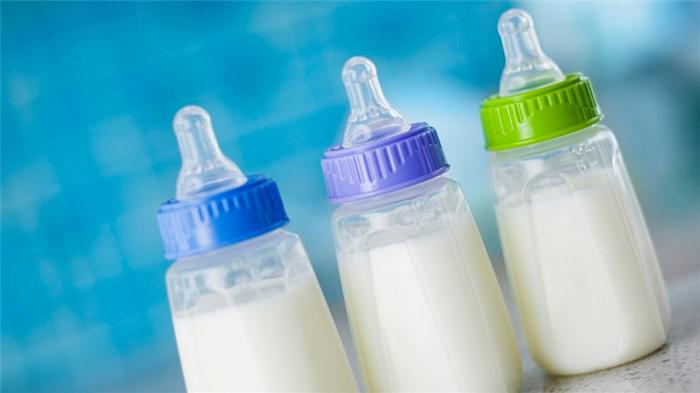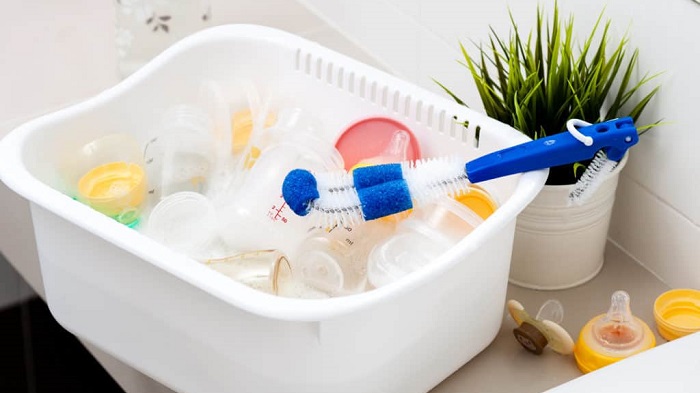“`html
As we know, cleaning baby bottles and other utensils is extremely important because in the first 6 months, a baby’s immune system is still very weak. Mothers need to pay attention to sterilizing baby bottles before feeding, even for newly purchased bottles.
Let’s take a look at the correct ways to clean baby bottles with DailySavingz to ensure comprehensive health for your baby.
1/ Cleaning new baby bottles
When using a baby bottle for the first time, mothers need to clean it with a brush and soapy water. Since it’s newly purchased, remember to scrub it thoroughly. Next, submerge the bottle in boiling water for about 5-10 minutes. Be careful not to let the bottle touch the pot as it is very hot and can melt or deform the bottle. Afterwards, take the bottle out and let it air dry in the sun until completely dry.
2/ Cleaning frequently used baby bottles
After each feeding, mothers also need to be very careful in the cleaning process. After thoroughly cleaning the bottle and nipple with cold water (remember to rinse the nipple opening multiple times to ensure it is clean), mothers begin the sterilization process. Bottle sterilization can be done in the following ways:

Cleaning baby bottles the right way
- Using chemical sterilizers in cold water (chlorine): Although it takes more time (over 30 minutes) and leaves a smell that can make the baby uncomfortable, this is a convenient method and completely safe even with silicone bottles.
- Boiling: Although inexpensive, it can easily degrade the quality of the bottle and may release toxins from the plastic in the bottle.
- Sterilizing with steam in sterilizers (sold in mother and baby stores): This method is quite popular because the steamer will automatically complete the task within a certain time (10-15 minutes) and at a specific temperature, ensuring bottle quality.
- Sterilizing with a microwave: This method is also quick, convenient, with stable time and temperature, however, it is not applicable to glass bottles.
3/ Cleaning frequency
Mothers should only sterilize thoroughly during the first 6 months of the baby’s life because when they are newborn, their bodies are still very delicate and their resistance is very weak, so we must sterilize all items related to feeding the baby. But when the baby starts to turn 6 months old, we don’t need to clean the bottle so strictly anymore because this can prevent the baby’s immune system from being trained to fight off diseases. Besides, after 6 months, the baby begins to explore the world and may put things within their reach into their mouths.
In addition, parents also need to note the following during the process of cleaning baby bottles:
- How to sterilize baby bottles?
When using the bottle for the first time, the mother must first sterilize it. Sterilizing a baby bottle is quite simple. First, the mother must wash the bottle with bottle cleaning solution. Pour a sufficient amount of water into the sink, add a little baby bottle cleanser to the water. Then, put all the baby bottles in the water and scrub them thoroughly with a brush.
Next, boil the baby bottles for about 5-10 minutes. Remember to submerge the bottles completely in water. Then, take the bottles out and place them in a clean place until they are completely dry.
- Sterilizing baby bottles – is it necessary?
For newborns, not only baby bottles but also countless other items need to be hygienic, such as: Teethers, pacifiers, breast pump funnels, bowls, spoons for solid foods, etc. Compared to the body of an adult, newborns do not have an immune system, so cleaning these items requires a very high level of “100% sterilization”. That’s why people are familiar with the concept of “Sterilization”.
To clean baby items, “Sterilization” is the final stage after they have been thoroughly cleaned with baby bottle cleanser and rinsed with clean water. The baby is only truly safe when the mother carefully sterilizes the bottles.
- Should or shouldn’t you sterilize with boiling water?
This is the most classic method. Mothers don’t have to buy anything, just a pot with a large enough capacity to boil the items for 20 minutes. However, this method is not as simple and convenient as people think. When sterilizing using this method, the mother always has to supervise the sterilization process. The bottle must be 100% submerged in water, and the boiling time must be 20 minutes. The pot’s sides are often hotter than 100 degrees Celsius, so if the bottle is placed close to the pot, it can easily melt. If the mother forgets the pot on the stove, all the items can be warped. After sterilization, if the lid is not tightly closed or soaked in water for too long, it creates conditions for bacteria to re-enter.

Cleaning milk storage bottles safely for mother and baby
- At what age do babies no longer need sterilization?
This depends on each child because each baby has a different immune system. According to pediatricians, usually, the immune system of children under 6 months of age is still immature, so they are prone to digestive disorders if the milk they drink is contaminated. However, mothers should not be too “fussy”. Continuous sterilization for more than 6 months will, on the contrary, prevent the baby’s immune system from being trained to fight diseases; sterilization at this point is also useless because at this age, the baby has begun to explore the world by putting everything within reach into their mouth.
- Safe bottle feeding for babies
Breast milk is always maintained at a moderate temperature so the baby can drink it easily. However, as they grow older, babies need to supplement with formula. This is the time when mothers need to pay special attention to issues related to baby bottles to ensure delicious, healthy, and safe meals for their babies.
- How to choose safe baby bottles
Choosing glass or plastic bottles for babies? This is a question many mothers wonder about. Glass bottles are usually heavier than plastic bottles but are safer because plastic bottles often contain the chemical Bisphenol A (BPA), which is not safe for health. This substance causes abnormal development of the reproductive system and brain in infants. Therefore, if choosing a plastic bottle for your baby, mothers should carefully check whether the bottle contains BPA or not. With glass bottles, mothers should choose lightweight bottles that can keep the milk warm for longer.
Parents can refer to some of the best baby bottle products currently available, such as: genuine Moyuum baby bottles, Hegen baby bottles,… These are some of the baby bottles trusted by many mothers for their children.
See details of baby bottle types:
- “Adjusting” baby bottle temperature
The first thing mothers need to remember is not to put the baby’s bottle in the microwave. Overly hot milk will make it impossible for the baby to drink or can cause burns to the throat when drinking. For baby bottle temperature, mothers should let the baby drink at a cool temperature or at room temperature. Ideally, before feeding the baby, soak the bottle in cold water for about two minutes to cool it down.
If the milk gets cold, use a cup or bowl slightly wider than the bottle’s mouth, pour hot water into it, and place the bottle inside to gradually warm it up.
- Checking milk temperature
Many mothers think that the milk temperature for their baby is suitable and don’t hesitate to feed the baby immediately. However, before feeding the baby, the mother should check the milk temperature again by dropping a few drops on her wrist. If the milk is warm, you can feed the baby immediately; if the milk is too hot, let it cool down more. If the milk is too cold, place the bottle in a bowl of warm water for a few minutes as instructed in section 2 before feeding the baby.
- Cleaning the nipple
The nipple part of the baby bottle is usually made of silicone or rubber and is produced using silver-coated technology for antibacterial properties. However, before preparing milk for the baby, the mother needs to clean the bottle and nipple with baby bottle cleanser and boil the nipple in hot water for about 3-4 minutes. This is the part of the baby bottle most susceptible to bacterial invasion and can affect the baby’s immune system. In addition, mothers should pay attention to replacing the bottle nipple about every three months to ensure food hygiene for the baby.
We hope that the above article can help mothers in cleaning baby bottles correctly for their children, so that the “task” of cleaning bottles for children every day becomes faster, more effective, and safer.
- Are Medela milk storage bottles good? Should I buy Medela milk storage bottles?
- Top 5 Best Selling Baby Bottle Sterilizers 2020
- Review of the 2 most trusted drying baby bottle sterilizers
“`
